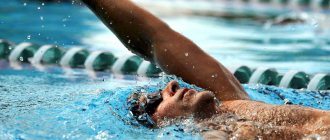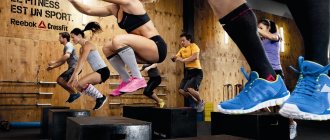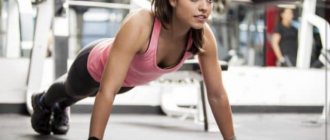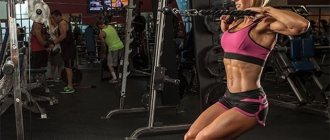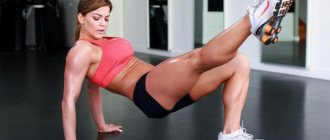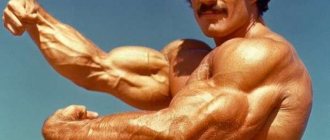Functional training gives you every opportunity to get an attractive, physically developed body. The program helps increase mobility, flexibility, and helps prevent household injuries. The effectiveness of exercise does not depend on where you practice. Even alone, in an apartment you can achieve excellent results. This does not require complex equipment; simple devices are sufficient. The exercises are often performed with your own body weight.
The program includes exercises for different muscle groups, you can perform them to rhythmic music. Functional fitness is extremely diverse in terms of load range and selection of exercises. These include squats, deadlifts, push-ups, and pull-ups. Movements are performed in different planes. The system also includes various jumps, lunges, and planks.
Exercises are combined into several cycles to increase endurance. The classes are easy to diversify and complicate. To do this, use a horizontal bar and parallel bars, elements with a barbell, weights, and cardio equipment.
What are the benefits of functional training?
- The technique harmoniously develops physical qualities - strength, strength endurance, speed, mobility, coordination.
- Proportionally strengthens the muscles.
- Improves the proportions of the figure, forms a strong, athletically developed body - as a result of exercise, fat is burned and aesthetic muscles appear.
- Speeds up metabolism, improves health.
- During training, stabilizer muscles that are not involved in other areas of fitness are well loaded.
Functional training refers to those rare programs that work stabilizing muscles and specific muscle groups that are passive in everyday life. This effect is achieved due to the special biomechanics of multi-joint exercises.
Functional training[edit | edit code]
Do not confuse this fitness program with the section of sports training that has a similar name, functional training.
Functional training
– training aimed at teaching motor actions, developing physical qualities (strength, endurance, flexibility, speed and coordination abilities) and their combinations, improving physique, etc. that is, what can fall under the definition of “good physical condition”, “good physical shape”, “athletic appearance”. (E.B. Myakinchenko)
It should be noted that “functional training” classes should be adequate to your state of health and level of physical fitness. It is also necessary to consult a doctor before starting training. And always remember - forcing the load leads to negative consequences for the body.
This is a fundamentally new stage in the development of fitness, offering ample opportunities for training. The pioneers of the development of this trend in fitness in our country were trainers Andrei Zhukov and Anton Feoktistov.
Functional training
Functional training was originally used by professional athletes. Figure skaters and speed skaters trained their sense of balance using special exercises, discus and javelin throwers trained explosive strength, and sprinters trained their starting push. Several years ago, functional training began to be actively introduced into the program of fitness clubs.
Dmitry Yashankin - Functional training.
One of the forerunners of functional training was Pilates. The usual abdominal crunch was proposed to be performed at a slow pace, which is why the stabilizer muscles responsible for posture were included in the work (A very controversial statement.
). From such an unusual load, even experienced athletes are exhausted at first.
The point of functional training is that a person practices the movements necessary for him in everyday life: he learns to easily stand up and sit down at a table or in a deep chair, skillfully jump over puddles, lift and hold a child in his arms - the list goes on and on, which improves strength muscles involved in these movements. The equipment on which training takes place allows you to make movements not along a fixed trajectory, as on conventional simulators, but along a free one - these are traction machines, shock absorbers, balls, free weights. Thus, your muscles work and move in the most physiological way for them, exactly as it happens in everyday life. Such training is significantly effective. The secret is that functional exercises involve absolutely all the muscles of your body, including the deep ones, which are responsible for stability, balance and the beauty of our every movement. This type of training allows you to develop all five physical qualities of a person - strength, endurance, flexibility, speed and coordination abilities.
The uniform and simultaneous development of the upper and lower muscle groups creates an optimal load on the entire bone structure, making our movements in everyday life more natural. It is possible to achieve the harmonious development of our entire morphofunctional system with the help of a new direction of modern fitness, which is quickly gaining momentum in its field and attracting an increasing number of fans of a healthy lifestyle - functional training. Functional training is the future of fitness.
5 principles of “Functional training” proposed by D. Sheptukhov
(FPA transfer case 2005):
- 1st principle: “Exercises in a standing position”
- 2nd principle: “Training using free weights”
- 3rd principle: “Basic exercises”
- 4th principle: “Speed style training”
- 5th principle: “Train movements, not muscles”
| Body Part/Total Strength | Monday | Wednesday | Friday |
| Overhead dumbbell squats | Deadlift on 1 leg | Deadlift | |
| Legs | Squats | Reaching | Leg press |
| Back | Standing lat pulldown | Front thrust | Single leg dumbbell row |
| Breast | Dumbbell bench press on ball | Bench press | Medicine ball push-ups |
| Shoulders | Seated dumbbell press | Arm abductions to the sides with pancakes | Seated barbell press |
| Press/Balance | Balance standing on the ball | Body lifts | Twist standing on CORE |
What sports qualities does functional training develop?
Bodyweight exercises improve strength:
- muscles become more developed, resilient and strong;
- different muscle groups work more harmoniously and economically, efficiency of movements is achieved;
- Stabilizing muscles are well developed and trained, as a result the musculoskeletal system is better protected from injury.
During training, speed and reaction indicators improve. The movements are performed using a high-speed, “explosive” technique. The heart, blood vessels, and respiratory system become resilient. Their safety margin and adaptive capabilities increase.
The “circular” or interval method has a positive effect on the body’s endurance and makes it easier to cope with any load. Favorable changes are also manifested in flexibility - joints and muscles become more elastic, and overall healthy mobility and mobility are achieved.
As a result of training, the athlete feels his own body perfectly, and his movements become coordinated. Balance appears, balance appears, posture improves.
Types of training
Functional training is a relatively young sports area. It continues to develop, giving birth to more and more new varieties.
Below we will list only those that have already formed and spread throughout the world.
Base
This is where PT began in sports and fitness. Namely, the use of various basic exercises in unusual conditions and starting positions.
This helps to include a large number of stabilizer muscles in the work, which are not involved in the classical versions of the technique.
Such movements include different variations of squats, lunges, and jumps. As well as weightlifting exercises, running and gymnastics on the horizontal bar, parallel bars, rings and rope.
TRX
Once upon a time, TRX loops made a lot of noise in the fitness world. Two bands with handles for resting your arms or legs, with fastening at the top to any stationary object - that’s all you need for training.
Some seriously argued that the nooses were a threat to the existence of gyms. And it will only take a couple of years before TRX replaces all types of strength training.
But time has put everything in its place. Gyms and strength sports withstood the pressure of the opponent. And exercises using slings have firmly occupied their niche in fitness.
Read more about it here.
Workout
Workout includes the usual exercises on the horizontal bar and parallel bars. Much less often - on gymnastic rings and rope.
In this case, classes are held outdoors, in the open air. This makes the process difficult during cold weather, but this does not bother avid followers of the direction.
Crossfit
Another type of functional training, with the advent of which experts predicted the disappearance of traditional gyms.
CrossFit is perhaps the most comprehensive direction in PT. It includes elements of different disciplines:
- weightlifting
- artistic gymnastics and acrobatics
- athletics
- bodybuilding
- kettlebell lifting
- some aspects of training from many sports
But to conduct full-fledged training, you need a large amount of sports equipment.
This means classes in specially equipped rooms. But thanks to the popularity of sports, there are already quite a lot of them.
Kengo Jump
The basis of the technique is training in shoes with special springs attached to the sole. Thanks to them, various jumping exercises are carried out.
As a rule, Kengo Jump classes are group functional training, which is carried out on an emotional high.
Classes like these are a great workout option for women. After all, the main load here falls on the muscles of the legs, buttocks and abdomen, to which girls pay increased attention.
An unusual and unstable starting position forces the body to expend a large amount of energy, connecting the body stabilizers more strongly. This helps you lose weight and improves muscle tone.
Bosu training
Here they use a special balancing platform in the form of a hemisphere - Bosu
Basic fitness exercises are performed on it. And the instability of the position, again, strengthens all the muscles and ligaments of the body, develops coordination and dexterity.
Circular
This can be either a separate type of functional training or an element of a training methodology in any other areas (basic, crossfit, TRX, workout and others).
The essence of circular exercises is the sequential execution of a set of exercises without rest between them.
Depending on the level of training, several consecutive circles are performed without rest, or with a minimal pause at the end of each circle.
As a result, the intensity increases significantly.
Interval training
The essence of interval training is alternating periods of maximum intense load with periods of light, which are repeated in several cycles in a row.
For example, the Tabata protocol , which was originally created to increase the aerobic and anaerobic capabilities of the body.
But as research progressed, it turned out that Tabata has other beneficial properties for health and physical fitness.
Who is functional training suitable for?
The technique is not designed for any narrow group of athletes; it is suitable for everyone - teenagers, mature and elderly people. The level of basic training also does not matter; the training program can be easily customized to suit your needs, gradually increasing the number of approaches and the complexity of the exercises.
Functional fitness is suitable for those who:
- wants to become slimmer, get rid of excess weight;
- improve physical fitness, become athletic and fit;
- strengthen muscles and ligaments;
- develop endurance for a more active lifestyle.
With desire and perseverance, everyone achieves excellent results - both those who regularly train at home or at the stadium, and those who go to the gym or fitness center.
This is the optimal system that is recommended for anyone who wants to get a lean, athletic body. But to get massive muscles, it is better to choose bodybuilding or powerlifting.
Benefits of functional training:
- strengthens muscles, increases tone, makes the body slim, athletic, fit;
- reduces body volume and weight;
- increases flexibility, endurance, balance, balance;
- strengthens the heart, blood vessels and respiratory system;
- improves mood and vitality;
- you can study at home;
- various exercises do not get boring.
For weight loss
Functional training allows you to quickly and comfortably lose excess weight. At the first stage, you need to determine your current height and weight, calculate your body mass index, and set your goals. It is imperative to take into account daily caloric intake and the characteristics of work activity. How the effect is achieved:
- gradual complication of training;
- increased heart rate, stimulating fat burning;
- developing flexibility, coordination and improving posture;
- availability of training and the ability to conduct it at home.
To lose weight quickly, you need to eat right and regularly create a calorie deficit. Tips for those planning to lose weight through functional training:
- Make a training plan in accordance with the characteristics of the body.
- Pay attention to every movement and bring the technique to automaticity.
- After mastering a new exercise, gradually introduce weights.
- Do not overuse manipulations on exercise machines.
- Be sure to train on TRX loops, which provide a complex load.
It is important to remember that in order to achieve the desired weight loss results, functional training must be combined with a proper nutrition system. It is necessary to give up flour, sweets, fried foods and reduce the consumption of alcoholic beverages.
Features of functional training in fitness
Each lesson in functional training is aimed at working all muscle groups. The load is divided into several circles (series), repeated one after another. Exercises follow one after another continuously, when the series is completed, you can rest.
The system is based on a number of principles:
- exercises are performed standing or resting on your hands;
- exercises with your own weight predominate in the training;
- The program includes multi-joint exercises;
- high-speed style of movements;
- the maximum number of muscles is worked out;
- gentle load on the spine, ligaments and joints;
- a “circular” approach is mainly used.
It is advisable to train 3 times a week and fully recover. The average ratio of aerobic and anaerobic load in this area of fitness is 30% to 70%. Much attention is paid to proper breathing and recovery. The break between classes should not be less than 1 day.
Ready-made training program
When performing exercises, it is necessary to control the position of the knee joints, arms and not allow the lower back to sag. It is very important to monitor your posture and breathing. To ensure you master a set of movements, it is advisable to take several lessons from a professional trainer. Popular today is the TRX system - an effective method of working using your own weight. To use the exercise machine correctly, you need to correctly adjust the straps and select the optimal stabilization coefficient. The loops ensure the development of key muscle groups, giving the body stability, flexibility and mobility. Depending on the capabilities, they are attached to a punching bag, door, pole or horizontal bar.
Functional training can be done in the gym, on the street or at home. Be sure to include a warm-up and cool-down in the lesson format. Breaks in the first stages should be taken according to how you feel, but not exceed one minute. Regular classes 2-3 times a week will allow you to achieve excellent results in the shortest possible time. The system allows you to gradually complicate the process and set new goals. An example of three classic functional training:
| Tuesday | Thursday | Saturday |
| 20 squats, 10 lumberjack exercises, 20 ab exercises, 10 jumping jacks, 60 seconds plank | 10 push-ups, 20 lunges in different directions, 5 burpees, 45 seconds of planks, 10 corner crunches | 10 push-ups, 20 reverse lunges, 10 dumbbell forward bends, 60 second planks, 15 sit-ups |
There are many options for creating functional training programs. The example provided is a guideline that can be modified and expanded to suit individual goals. The system, created for personal tasks, allows you to see the first results after just a few lessons.
Cons and contraindications
If your goal is to build muscle mass, this training will not work. It makes the body strong, muscular, toned, but functional training in fitness does not provide relief and volume, as in strength sports and bodybuilding.
The training is aimed at all muscle groups, this is the strong and at the same time weak side of the training. In the process of functional training, athletic qualities are harmoniously developed, but without phenomenal results in strength, flexibility, and other individual indicators and components.
Additionally, some bodyweight exercises require at least a minimum of basic physical fitness to perform.
There are also contraindications to functional training:
- diseases of the heart and blood vessels;
- diseases and injuries of the spine;
- disorders of the central nervous system;
- kidney problems;
- acute injuries, instability of the musculoskeletal system;
- infections, acute inflammatory process;
- exacerbation of a chronic disease;
- pregnancy.
Minor health problems are not a contraindication to exercise. Any exercise can be adapted to the state of the body and the level of training, simply by reducing the number of circles and repetitions, adjusting the duration of rest and simplifying the technique (for example, push-ups from a chair or from a wall).
Functional training programs[edit | edit code]
Burpee exercise
Functional training has a huge variety of exercises, techniques and their variations. But initially there weren’t many of them. There are several basic exercises that form the backbone of functional training.
Bodyweight exercises
:
- Squats - they can be varied (on two legs, on one leg, with legs spread wide, etc.)
- Back extension - legs are fixed, hips rest against the support, back is in a free state, hands behind the head. The back rises from a position of 90 degrees, in line with the legs and back.
- Jumping - from a squatting position, the athlete jumps onto an improvised pedestal and then jumps back.
- Burpee is an exercise similar to the usual push-ups, only after each push-up you need to pull your legs to your chest and jump up from this position, while clapping your hands above your head.
- Push-ups upside down - we approach the wall, focus on our hands, lift our feet off the ground and press them against the wall. In this position, we do push-ups, touching the floor with our heads.
- Jump rope - even a child knows this exercise. The only difference between this exercise in functional training is that the jump is made longer in order to have time to spin the rope around itself twice. In this case, you have to push off harder and jump higher.
- Lunges - the athlete takes a wide step forward from a standing position, then returns back. The supporting leg should almost touch the floor, and the landing leg should bend no more than 90 degrees.
Exercises with gymnastic apparatus
:
- Corner - on parallel bars, rings or other support with straight arms, raise your straight legs parallel to the floor and hold them in this position for several seconds. You can straighten one leg at a time. Your torso should form a 90-degree angle with your legs.
- Pull-ups on rings - holding gymnastic rings in your hands, raise your body with your arms until it reaches 90 degrees, then suddenly lunge upward, straightening your arms. Return to the position of bent elbows, lower to the floor.
- Dips - holding your body weight on your arms, elbows bent parallel to the floor, sharply straighten your arms, then return to the starting position. The back should be perpendicular to the floor and not deviate.
- Climbing along a rope - resting your hands and feet on the rope and grasping it, push off and climb up the rope.
- Pull-ups on the crossbar are the usual pull-ups for us on the horizontal bar, when from a hanging position the body is pulled up with the force of the arms.
Distance exercise
:
- Cross-running is a fast run back and forth, when the athlete runs between a distance of 100 meters and 1 km.
- Rowing - a simulator is used, the technique of which is reminiscent of rowing with oars on a boat. Distances from 500 to 2000 meters are covered.
Exercises with weights
:
- Deadlift - from a sitting position, grasping the barbell shoulder-width apart, the athlete rises on straightened legs and lifts the barbell off the floor. Then returns to its original position.
- Push - from a sitting position, grasping the bar slightly wider than the shoulders, the athlete rises on straightened legs and lifts the bar off the floor, lifting it to his chest. After this, he jerks the barbell overhead with straightened arms.
- Barbell Squats – The barbell rests on your shoulders and is supported by your arms, with your feet shoulder-width apart. The athlete squats deeply and rises to straightened legs.
- Swing with a weight - holding a weight with both hands, the athlete lifts it above his head and lowers it between his legs and back up, but on the principle of a swing.
This is just a small part of what functional training uses in its training programs.
Functional training for weight loss[edit | edit code]
Functional training is perhaps the best workout for weight loss. It is so intense that calorie consumption occurs at an accelerated pace. Why functional training?
- First, this workout will help you keep your heart rate high. This means that energy consumption will occur much faster than with static, sedentary training.
- Secondly, your breathing will be intense and frequent. This means that the body will consume more oxygen than usual. There is an opinion that if the body does not have enough oxygen, it borrows oxygen from the muscles. To prevent this from happening, you need to train your lungs.
- Third, functional training trains your strength and endurance.
- Fourthly, intense training using the functional training system uses many muscle groups at the same time, which allows you to burn a lot of calories. After such a workout, your metabolic rate increases.
- Fifthly, lifting heavy weights will contribute to muscle tissue injury during training and its recovery after. This means that your muscles will grow and expand while you rest. You'll burn calories even if you're lying on the couch.
- Sixthly, training according to the functional training system is usually not too long - from 20 to 60 minutes. That is, in 20 minutes a day you will work so hard that you will wish you were dead. These are very difficult workouts.
Tips for beginners
Before you start exercising, determine your desired goals. Keep a training diary and write down what you want to achieve - reduce fat mass, build an athletic figure, become physically stronger and stronger.
Depending on the goals and starting capabilities, the instructor draws up a training program.
General rules for beginners:
- Gradually increase the load - volume, intensity and complexity of exercises.
- Strive for self-discipline - train regularly, record your loads.
- Monitor your diet and keep a diary. It is advisable to change the ratio of products in favor of protein. Limit the percentage of fast carbohydrates.
- Weigh yourself regularly.
- Strive to improve your level, compete first of all with yourself.
For beginners, circuit training consisting of exercises without weights is good. Gradually increase the speed and range of movements. If your goal is to lose weight, you must be in a calorie deficit, otherwise it will be difficult to achieve what you want. It is recommended to include cereals, meat, eggs, nuts, and vegetables in the diet.
Over time, for better results you will need sports nutrition - protein, creatine, vitamin complexes for muscle development, bone strength and ligaments.
Functional training is accessible to many, regardless of the initial level of training. The main thing for beginners is a normal level of health, the absence of serious contraindications and the choice of an adequate load.
Features of weight loss training
D. Smirnov, mentioned at the beginning of the article, believes that training for weight loss exists. And this is something like a circuit with fairly serious weights and multi-joint basic exercises. Cardio – interval. Diet – with a calorie deficit. All other methodologists believe that such exercises serve to increase strength endurance in sports, and a simple gym goer does not need all this.
In practice, functional training is used to “speed up metabolism.” This is a real task if a person has decent joint mobility, good technique, he is ready not to “destroy” weights as soon as he goes on a calorie deficit, and is able to recover.
CrossFit recommends that those losing weight get rid of sweets and build a diet based on cereals, meat, eggs, nuts, vegetables and herbs.
Most beginners should do some sort of circuit training of exercises with no (or minimal) weights and try to build up range and tempo. And, of course, do not forget about the calorie deficit, without which any workout will not be effective.
Do you need all sorts of barefoot lunges and other exotic versions of movements with medicine balls to lose weight? Actually, no. This is the main complaint of all sensible humanity about functional club fitness. The average person will take too long to figure out how to repeat the exercise in order to do it beautifully and effectively. It is better to make the work technically simpler, but not to interrupt it to look again at what the instructor is showing there.
How is the lesson going?
The training begins with a warm-up. Since functional exercises involve active movements, jumping, and strength exercises, you need to warm up the joints and muscles in advance, the body must be ready for complex amplitudes and explosive tempo. A good warm-up improves the effectiveness of movements and prevents injuries.
Any basic aerobic exercise is suitable as a warm-up - walking, jogging, jumping rope, cardio equipment. The duration of the lesson is from 30 minutes to 1 hour, depending on basic training and goals.
Training plans[edit | edit code]
Perform each exercise only once in one series. there is no need to do the same exercise four times in a row and then move on to the next one.
The workout plan pictures only show the starting and ending positions of the exercise so you can remember it.
Beginner level[edit | edit code]
- Day 1
- Day 2
- Day 3
- Day 4
- Day 5
- Day 6
- Day 7
- Day 8
- Day 9
- Day 10
- Day 11
- Day 12
- Day 13
- Day 14
- Day 15
- Day 16
- Day 17
- Day 18
- Day 19
- Day 20
- Day 21
Advanced level[edit | edit code]
- Day 1
- Day 2
- Day 3
- Day 4
- Day 5
- Day 6
- Day 7
- Day 8
- Day 9
- Day 10
- Day 11
- Day 12
- Day 13
- Day 14
- Day 15
Professional level[edit | edit code]
- Day 1
- Day 2
- Day 3
- Day 4
- Day 5
- Day 6
- Day 7
- Day 8
- Day 9
- Day 10
- Day 11
- Day 12
- Function training148.jpg
Day 13
- Day 14
- Day 15
Functional training for weight loss
The program is suitable for losing weight and speeding up metabolism. Functional fitness training promotes active fat burning; it is one of the most effective methods for increasing muscle mass and reducing fat percentage. Many calories are burned during and after high-tempo workouts involving different muscle groups. You can combine exercise with taking L-carnitine, a sports nutrition that stimulates fat burning.
To achieve sustainable weight loss, you need to exercise at least every other day. It is advisable to organize your diet properly and eat more protein foods. If you train irregularly and for less than 30 minutes, you should not expect sustainable results.
What he really is?
Functional training is a new trend in fitness culture. It is aimed at the harmonious, speedy and comprehensive development of the human body and all its physical qualities. Functional training allows you to develop qualities necessary for everyday life - speed of reaction, endurance during non-standard work, and the like.
Have you ever dug anything? It doesn’t matter whether it’s potatoes or an ordinary pit. The main thing is muscle pain. And if you think that a trained athlete who has been training for more than 5 years will not have any pain after an hour of manipulating with a shovel, then you are mistaken. Completely different skeletal muscles work there.
Yes, digging up potatoes can be called functional training aimed at developing skeletal muscles and coordination. It is for this reason that such training was invented - so that everyday tasks do not cause difficulties when performing them.
I hope you understand the principle of the training?
Is it possible to gain muscle mass through functional training?
The training is not initially intended to pump up muscles. The emphasis in this system is on overall body development rather than on the strength and mass of individual muscles. When choosing this method, you should not expect a noticeable increase in body volume and expressive athletic relief. However, there are ways to still achieve muscle gain:
- do more movements with weights (barbells, dumbbells, kettlebells) and strength exercises (pull-ups, push-ups, squats);
- the optimal number of repetitions per approach is 12-15;
- train twice a week or three, but working different muscle groups;
- Follow a high-protein diet and creatine to increase explosive strength and muscle size.
Functional and specific strength[edit | edit code]
Source: "Training Programs"
, scientific ed.
Author:
Professor, Doctor of Science Tudor Bompa, 2016
Specific strength is often confused with functional strength. The term functional strength is fairly new and refers to exercises performed using a variety of equipment—balls, ABS (plastic) foam tubing, and a proprioceptive platform—that are designed to challenge the environment to increase the involvement of the small and deep stabilizer muscles. [1]. But does anyone really think that athletes won the Olympics, World Championships, and set world records and yet did not work or did not work properly on specific strength before the year 2000?
In fact, specific strength and functional strength are not synonymous. Sport-specific strength training involves replicating the specific form of force required for a chosen sport from a metabolic and neural perspective. The training process is based on exercises that duplicate the action of kinetic chains as part of specific motor skills (including a certain range of joint motion and force vector). Particular attention is paid to the main driving muscles without disturbing the movement pattern that is part of the technique of the sport.
The term functional strength, on the contrary, is not related to the physiological and biomechanical parameters of a specific sports discipline or motor skill, but is more often considered as a designation of a method of training strength, i.e. Functional strength training involves the use of free weights or pulleys, unilateral training, and possibly standing pulleys in multiple planes (exceptions to this definition include propaedeutic exercises and some core development exercises). In other words, when it comes to training specific strength, the most essential starting points are the biomechanical and physiological parameters of the sports discipline. Functional training, on the other hand, is simply defined by the use of exercises with the characteristics listed above.
The statement that the choice of exercise fully determines the degree of functionality of a strength training program is obviously incorrect from a methodological point of view, but it can be said with complete confidence that the best functionalists apply the concept of periodization of strength in planning. Additionally, when defining exercises, functionalists take into account not only biomechanics, but also consider physiology when selecting loading parameters, rather than favoring certain exercises and techniques. However, the question to ask yourself is: To what extent do certain functional training methods meet the goal of achieving the required level of maximum strength for certain strength sports (for example, the single-leg squat while holding a hanging band)? It should be understood that strength periodization is a more complex concept than functional training, and the basis of specific strength is biomechanics and psychology, rather than novelty and variability of exercises or simple imitation of movements from a particular sport.
Equipment and clothing for training
Most of the exercises are performed with your own weight and improvised means, sometimes light dumbbells, barbells, and weights are added. You can exercise anywhere - in the gym, on the sports ground, in the yard, at home. If desired, you can diversify the exercises by adding special fitness equipment: expanders, cables, elastic loops. Ropes, fitballs, and jump rope can be used. The classic gymnastic horizontal bar, rings, and parallel bars are great for practicing. You can add cardio exercises (treadmill, exercise bike, rowing machine) to your circuit training.
Clothing should be comfortable and not restrict movement. This can be standard fitness equipment or special kits, for example, for CrossFit. Regular sportswear for functional fitness training - tights or shorts, a T-shirt, a sports top, comfortable sneakers made of elastic material with a stable sole.
Benefits for the body
Let’s figure out why millions of people love this destination:
- Development of motor qualities
Almost all sports focus on training only 2-3 physical qualities.
For example, even all-around sports, which were conceived as disciplines for the comprehensive physical development of a person, do not contribute to the maximum progress of all five motor qualities.
Functional training does not have such a disadvantage. Strength, endurance, flexibility, coordination and speed - they try to work on all these qualities evenly.
- Suitable for all fitness levels
If you look at crossfit or workout competitions, the athletes will seem like just terminators, they can withstand such inhuman loads.
Therefore, many people have the impression that such training is the most difficult and is suitable only for athletes with a high level of training.
But in fact, the level of load is selected depending on the degree of physical fitness of a particular person.
The set of exercises and overall training volume will be different for a beginner and a professional. Therefore, even a novice athlete can cope with a simple complex.
- Reduce the risk of injury in everyday life
The simultaneous development of all motor qualities is to prevent the risk of household injuries.
Often people get injured “out of the blue” precisely because of their low level of physical fitness. For example, due to poor flexibility or weak muscle tone.
- No need to go to the gym
Many types of training are democratic in terms of location. You can exercise anywhere, at any time of the year, with a minimum amount of sports equipment.
This includes, for example, classes with TRX loops or workout.
- Holistic health promotion
Most people start exercising primarily to improve their health.
Such classes in this regard are among the most effective, if you do not pretend to be at a professional level.
Conclusions – why is it worth doing functional fitness?
Functional training promotes versatile sports progress - with each training session you gain strength, endurance, speed, and flexibility. Training is available to everyone, the system has a minimum of contraindications. It is easy to organize the training process at home. Classes do not take much time. Interval circuit training with minimal rest between sets allows you to work all muscle groups in 30-40 minutes.
Functional training can improve athletic fitness, reduce fat mass, and strengthen the heart and lungs. The result is visible after 1-2 months of regular training.
Basic exercises and types of equipment
The variety of types of PT implies the same amount of exercises and equipment.
In fact, anything can be a training apparatus. Starting from your own body weight or standard sports equipment, ending with any object at home or on the street (heavy stone or mop).
However, here are the main types of exercises and equipment that are used most often:
- With its own weight
Here, various exercises are performed without improvised objects (squats, bends, push-ups), and with the use of gymnastic equipment (crossbar, parallel bars, rope, rings).
Additional weights are not used.
- With weights
The vast majority use free weights:
- Standard sports equipment - barbell, weights or dumbbells
- Non-standard – hammer, trolley with load, etc.
Working with free weights (including your own body weight) promotes the comprehensive development of stabilizer muscles.
- With gymnastic apparatus
These types of equipment are most widely used in workouts. Crossbar, parallel bars, rings, rope, monkey bars - these are the main types of gymnastics training equipment.
Here, not only your own weight is used, but also additional weights. For example, barbell discs, heavy chains, leg weights, a fitness vest.
- Cardio loads
Almost all types of PT include cardio exercises.
As a rule, this is running - sprint (short) distances to develop the anaerobic capabilities of the body, as well as medium and long distances to develop the aerobic mechanism of energy supply.
Muscle gain
If a decrease in the level of subcutaneous fat occurs naturally when exercising using a similar method, then gaining muscle mass becomes more and more difficult.
Adherents of the trend claim that this type of training helps to increase muscle volume throughout the body. Of course, they are a little disingenuous.
Although the training is carried out in a strength mode, it primarily develops strength endurance .
This type of load is focused on the development of slow, endurance muscle fibers that are difficult to hypertrophy. It is believed that they provide about 20% of muscle volume.
As a result, representatives of any direction of functional training have developed, but not too large muscles. At the same time, the body relief here is at the same level all year round.
If the goal is a tangible increase in muscle mass, then traditional bodybuilding classes in the gym are more suitable for this.
Here, training programs are used that focus on the development of fast-twitch power muscle fibers. As is known, they provide about 60% of the total muscle volume.
Exercises for weight loss
Any type of PT is an energy-intensive physical activity that is accompanied by large calorie losses. Therefore, almost all of its directions are suitable for weight loss.
The leader in this parameter is CrossFit. After all, the basis of the training program here is basic multi-joint exercises with free weights.
Jumping movements and exercises on gymnastic apparatus will be performed. Plus mandatory cardio exercise.
Circular training (less often interval training) stimulates high energy expenditure. And it often happens that weight loss occurs only through regular exercise, even without following strict diets.

